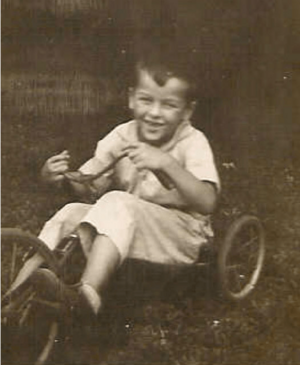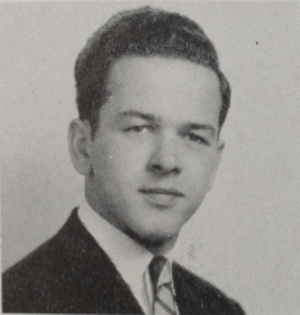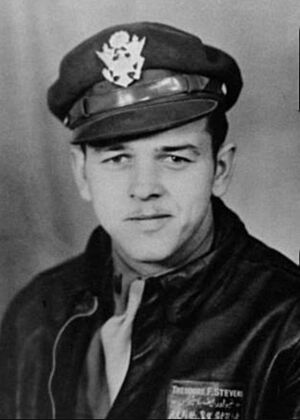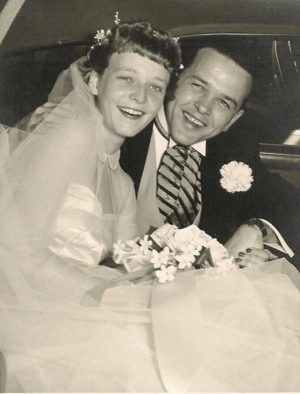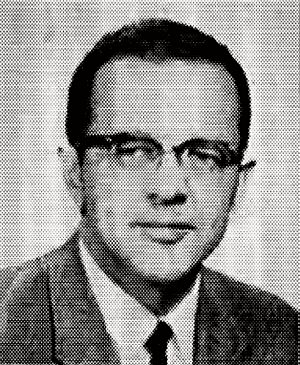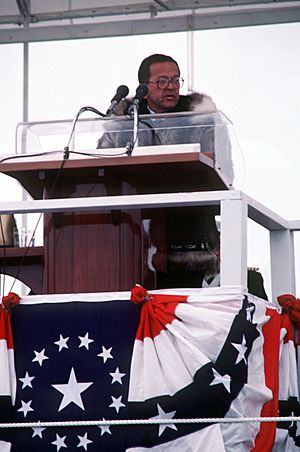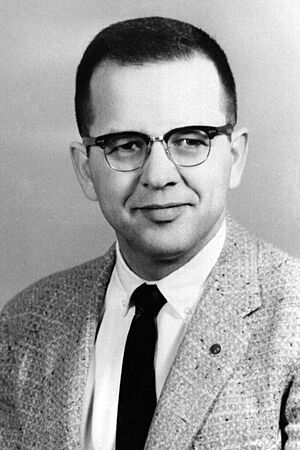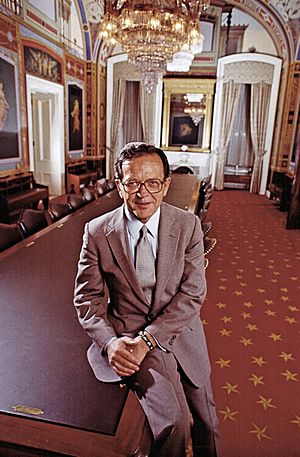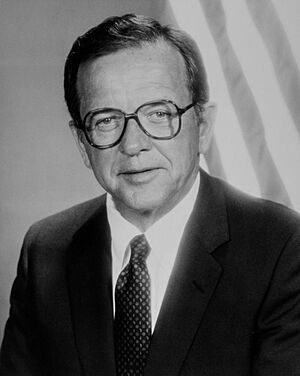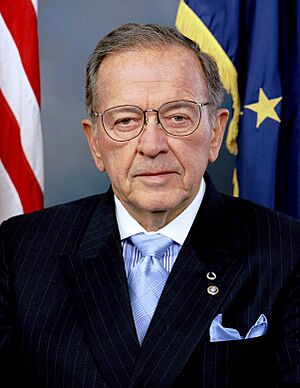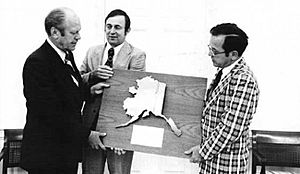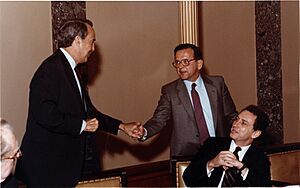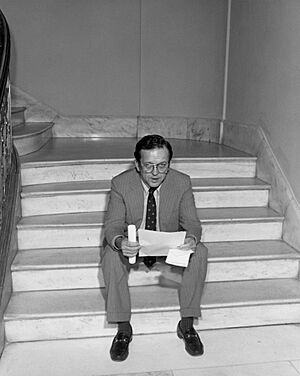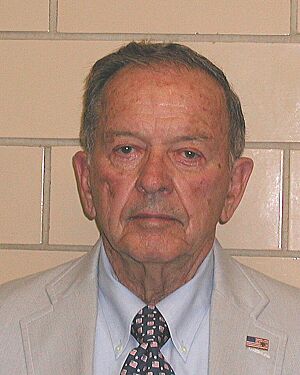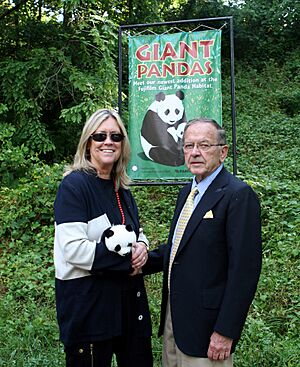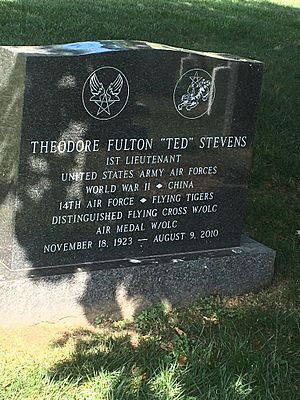Ted Stevens facts for kids
Quick facts for kids
Ted Stevens
|
|
|---|---|

Stevens in 1997
|
|
| United States Senator from Alaska |
|
| In office December 24, 1968 – January 3, 2009 |
|
| Preceded by | Bob Bartlett |
| Succeeded by | Mark Begich |
| President pro tempore emeritus of the United States Senate | |
| In office January 3, 2007 – January 3, 2009 |
|
| Preceded by | Robert Byrd |
| Succeeded by | Patrick Leahy (2015) |
| President pro tempore of the United States Senate | |
| In office January 3, 2003 – January 3, 2007 |
|
| Preceded by | Robert Byrd |
| Succeeded by | Robert Byrd |
| Senate Majority Whip | |
| In office January 3, 1981 – January 3, 1985 |
|
| Leader | Howard Baker |
| Preceded by | Alan Cranston |
| Succeeded by | Alan K. Simpson |
| Acting Senate Minority Leader | |
| In office November 1, 1979 – March 5, 1980 |
|
| Preceded by | Howard Baker |
| Succeeded by | Howard Baker |
| Senate Minority Whip | |
| In office January 3, 1977 – January 3, 1981 |
|
| Leader | Howard Baker |
| Preceded by | Robert P. Griffin |
| Succeeded by | Alan Cranston |
| Member of the Alaska House of Representatives from the 8th district |
|
| In office January 3, 1964 – January 3, 1968 |
|
| Preceded by | Multi-member district |
| Succeeded by | Multi-member district |
| Solicitor of the United States Department of the Interior | |
| In office September 15, 1960 – January 20, 1961 |
|
| President | Dwight Eisenhower |
| Secretary | Fred Seaton |
| Preceded by | George W. Abbott |
| United States Attorney for the Fourth Division of Alaska Territory | |
| In office August 15, 1953 – June 1956 Acting: August 15, 1953 – March 30, 1954 |
|
| President | Dwight Eisenhower |
| Preceded by | Robert McNealy |
| Succeeded by | George Yeager |
| Personal details | |
| Born |
Theodore Fulton Stevens
November 18, 1923 Indianapolis, Indiana, U.S. |
| Died | August 9, 2010 (aged 86) Dillingham Census Area, Alaska, U.S. |
| Resting place | Arlington National Cemetery |
| Political party | Republican |
| Spouses |
|
| Children | 6, including Ben |
| Education | |
| Signature | |
| Military service | |
| Allegiance | United States |
| Branch/service | United States Army |
| Years of service | 1943–1946 |
| Rank | First lieutenant |
| Unit | United States Army Air Forces |
| Battles/wars | World War II, The Hump |
Theodore Fulton Stevens Sr. (November 18, 1923 – August 9, 2010) was an American politician and lawyer. He served as a U.S. Senator for Alaska from 1968 to 2009. He was the longest-serving Republican Senator in history when he left office. This record was later broken by Senator Orrin Hatch.
Stevens worked in public service for six decades, starting as a pilot in World War II. In 1952, he moved to Fairbanks, Alaska, to start his law career. The next year, President Dwight D. Eisenhower appointed him as a U.S. Attorney. In 1956, he returned to Washington, D.C., to work for the Interior Department. He helped lobby for Alaska to become a state.
After losing a Senate election in 1962, Stevens was elected to the Alaska House of Representatives in 1964. He became the House majority leader in his second term. In 1968, he was appointed to Alaska's other Senate seat when it became empty. As a Senator, Stevens helped create laws that shaped Alaska's economy and society. These laws included the Alaska Native Claims Settlement Act and the Trans-Alaska Pipeline Authorization Act. He also helped create the United States Olympic & Paralympic Committee through the Amateur Sports Act of 1978.
In 2008, Stevens lost his re-election bid to Mark Begich. He was the most senior U.S. Senator to ever lose a re-election. Stevens passed away on August 9, 2010, in a plane crash near Dillingham, Alaska.
Contents
Early Life and Career
Growing Up in the United States
Ted Stevens was born on November 18, 1923, in Indianapolis, Indiana. He was the third of four children. His family later moved to Chicago, but his father lost his job during the Great Depression. When Ted was six, his parents divorced. Ted and his siblings went to live with their grandparents in Indianapolis.
Ted helped support his family by working as a newsboy. He remembered selling many newspapers on March 1, 1932, when headlines announced the Lindbergh kidnapping. In 1938, Ted moved to Manhattan Beach, California, to live with his cousin's mother.
He attended Redondo Union High School. He was active in school, working on the newspaper and joining a theater group. He also worked jobs before and after school. He still found time to go surfing with his friend Russell Green.
Military Service in World War II
After graduating high school in 1942, Stevens studied engineering at Oregon State University. When World War II was happening, he tried to join the Navy as a pilot but failed the eye exam. After improving his vision, he joined an Army Air Force Air Cadet program in 1943. He earned his pilot wings in early 1944.
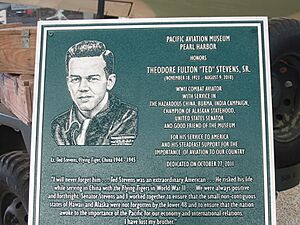
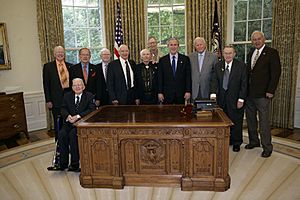
Stevens served in the China-Burma-India theater from 1944 to 1945. He flew transport planes to support Chinese units fighting the Japanese. He received the Distinguished Flying Cross for flying behind enemy lines. He also received the Air Medal and the Yuan Hai Medal from the Chinese Nationalist government. He left the Army Air Forces in March 1946.
College and Law School
After the war, Stevens attended the University of California, Los Angeles (UCLA). He earned a Bachelor of Arts degree in political science in 1947. He then went to Harvard Law School. The G.I. Bill helped pay for his education. He also worked as a bartender and sold his blood to cover costs.
While at Harvard, Stevens wrote a paper on maritime law. This paper later became an article in the Harvard Law Review. He graduated from Harvard Law School in 1950.
Starting His Legal Career
After graduating, Stevens worked at a law firm in Washington, D.C. The firm specialized in natural resources issues. One of their clients was Emil Usibelli, who owned a coal mine in Alaska. Stevens was assigned to handle his legal matters.
Family Life
In 1952, Stevens married Ann Mary Cherrington. She was a Democrat and worked for the State Department.
On December 4, 1978, a plane crash at Anchorage International Airport killed five people. Stevens survived with injuries, but his wife Ann did not. A building in Anchorage is named in her memory.
Stevens and Ann had three sons and two daughters. Their son, Ben, later served as president of the Alaska Senate.
Ted Stevens married again in 1980 to Catherine Bittner. They had one daughter, Lily.
Stevens lived for many years in Anchorage. His last home was in Girdwood, a ski resort community near Anchorage.
Health and Advocacy
Stevens was a survivor of prostate cancer. He spoke publicly about his experience. He supported creating a research program for prostate cancer at the Department of Defense. This program has funded millions of dollars for research.
Early Career in Alaska
In 1952, Stevens volunteered for Dwight D. Eisenhower's presidential campaign. He wrote papers on water and land laws. After Eisenhower won, Stevens was offered a job with the Fairbanks, Alaska, law firm of Charles Clasby.
In February 1953, Stevens and his wife drove from Washington, D.C., to Fairbanks, Alaska. They traveled on the Alaska Highway in winter. Ann Stevens later said they moved to Alaska "on a six-month trial basis."
In Fairbanks, Stevens became friends with C.W. Snedden, a conservative newspaper publisher. Snedden helped Stevens learn about diplomacy.
Serving as U.S. Attorney
In August 1953, Stevens was asked to serve as U.S. Attorney for Fairbanks. This was a temporary role until President Eisenhower could appoint someone permanently. Most local lawyers were upset because Stevens was new to Alaska. However, Stevens was favored by the Attorney General and the Republican National Committee. He was confirmed on March 30, 1954.
Stevens quickly became known as a strong prosecutor. He actively pursued violations of federal and local laws. He sometimes joined U.S. Marshals on raids. He gained a reputation for his strong temper.
In 1956, Stevens prosecuted Jack Marler in a trial that made national news. Marler was accused of not filing tax returns. Marler's lawyer argued that Alaskans should not pay taxes without representation in Congress. The jury found Marler not guilty. Stevens said the decision would hurt Alaska's chances of becoming a state.
Working for the Department of the Interior
Helping Alaska Become a State
In March 1956, Stevens returned to Washington, D.C., to work for the Department of the Interior. He became a key person in the effort to make Alaska a state. His office was even called "Alaskan Headquarters." He became known as "Mr. Alaska."
Efforts to make Alaska a state had been going on since 1943. The national Republican Party was against it, fearing Alaska would elect Democrats. Southern Democrats also opposed it.
Stevens worked with other officials to address President Eisenhower's concerns about Alaska's size and sparse population. They created a compromise that became part of the Alaska Statehood Act. This allowed the president to set aside land for defense if needed.
Stevens also helped lobby for the statehood bill. He worked closely with the Alaska Statehood Committee. He and his team gathered information on members of Congress to help convince them to support statehood. They also planted questions about Alaska statehood at presidential press conferences and placed editorials in newspapers.
The Alaska Statehood Act became law on July 7, 1958. Alaska officially became a state on January 3, 1959. On September 15, 1960, Stevens became the Solicitor of the Interior. He held this position until January 20, 1961.
Serving in the Alaska House of Representatives
After returning to Alaska, Stevens started a law firm in Anchorage. He was elected to the Alaska House of Representatives in 1964. In his second term, he became the House Majority Leader.
U.S. Senator
Serving Alaska in the Senate
Stevens's time as a U.S. Senator began with some challenges. He and Alaska's other new Senator, Mike Gravel, had disagreements. In March 1969, at their first committee meeting, Stevens spoke loudly about the need to settle Alaska Native land claims. This led to a shouting match between Stevens and Gravel.
Stevens was still learning Senate rules. In April, he lectured the committee chairman, Henry M. Jackson, who then reminded Stevens that he was new and needed to learn how things were done.
On October 13, 1978, the Alaska National Interest Lands Conservation Act was blocked by Senator Gravel. This bill aimed to protect a large part of Alaska's wilderness. Gravel's actions angered many, including Stevens. Senator John A. Durkin of New Hampshire openly criticized Gravel's actions.
On December 4, 1978, Stevens was in a plane crash in Anchorage. He survived, but his wife Ann and four others died. This event deeply affected Stevens. He later hinted that the crash happened because he had to work to fix the land bill, which Gravel had blocked.
In 1979, Stevens supported Clark Gruening to challenge Gravel in the next election. Gruening defeated Gravel in the primary election.
Stevens's strong personality helped him pass important bills. These included the Alaska Native Claims Settlement Act in 1971 and the Trans-Alaska Pipeline Authorization Act in 1973. He also worked with Senator Warren Magnuson on the Magnuson–Stevens Fishery Conservation and Management Act, which he considered a key achievement. These successes made him very popular in Alaska.
Stevens easily won re-election until his defeat in 2008. Later in his career, Stevens was known for bringing a lot of federal money to Alaska. He was proud of this, once saying, "I'm guilty of asking for pork, and I'm proud of the Senate for giving it to me."
Senate Elections
After practicing law, Stevens ran for the U.S. Senate in 1962. He won the Republican nomination but lost the general election to Ernest Gruening. In 1968, he ran again but lost the Republican primary. However, in December 1968, after Senator Bob Bartlett died, Governor Wally Hickel appointed Stevens to the vacant seat.
In a special election in 1970, Stevens won the right to finish Bartlett's term. He won the seat in his own right in 1972. He was re-elected many times, never getting less than 66% of the vote until 2008.
Stevens lost his re-election bid in 2008 to Mark Begich. He was the longest-serving U.S. Senator in history to lose a re-election. Stevens had planned to run for a rematch in 2014 but passed away in a plane crash in 2010.
Committee Roles and Leadership
Stevens served as the Assistant Republican Leader (or Whip) from 1977 to 1985. He also served as Acting Minority Leader when Howard Baker ran for president in 1980. In 1994, when Republicans gained control of the Senate, Stevens became Chairman of the Senate Rules Committee.
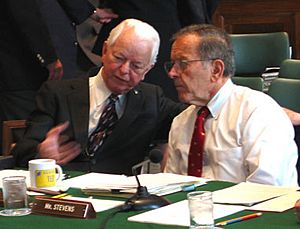
Stevens became the President Pro Tempore of the Senate in 2003. This role is usually held by the most senior member of the majority party.
Stevens chaired the Senate Appropriations Committee from 1997 to 2005. This position gave him a lot of influence, as he controlled funds for projects in different states. Even before becoming chairman, he secured large amounts of federal money for Alaska.
He also chaired the United States Senate Committee on Commerce, Science and Transportation during the 109th Congress. Stevens also led the Senate Governmental Affairs Committee and the Senate Ethics Committee at different times.
Because of Stevens's long time in office and the long service of Alaska's only congressman, Don Young, Alaska had a lot of power in national politics, even with its small population.
Political Views and Actions
The Internet and "Series of Tubes"
On June 28, 2006, during a Senate committee hearing, Stevens spoke about a bill related to telecommunications. He explained his opposition to a rule that would have created strong network neutrality mandates. Stevens famously described the Internet as "not a big truck," but a "series of tubes" that could get clogged. He also confused the terms Internet and e-mail.
His comments became a topic of humor and discussion online and on TV shows. Some journalists defended his "series of tubes" metaphor, saying it was a reasonable way to describe how data moves.
Views on Logging
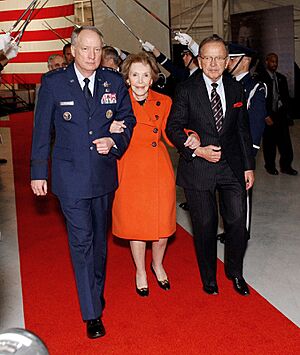
Stevens strongly supported logging. He pushed for a plan to allow logging in large areas of old growth forest. He believed this would help Alaska's timber industry and create jobs. However, critics pointed out that building roads for this logging would be very expensive for taxpayers.
Climate Change Views
For a long time, Stevens was doubtful about human-caused climate change. In early 2007, he acknowledged that humans were changing the climate and began supporting efforts to fight climate change. However, in September 2007, he claimed that the Earth was at the end of a long warming period and would start getting cooler. Scientists generally agree that the climate will continue to warm as long as greenhouse gases are added to the atmosphere.
Civil Rights and the Supreme Court
Stevens voted to establish Martin Luther King Jr. Day as a federal holiday. He also voted for the Civil Rights Restoration Act of 1987. He supported the nominations of Robert Bork and Clarence Thomas to the U.S. Supreme Court.
Legal Challenges and Outcome
Investigation and Charges
On July 29, 2008, Stevens was charged with not reporting gifts properly. These charges were related to home renovations and gifts he allegedly received from a company called VECO Corporation. The investigation was part of a larger probe into political activities in Alaska.
Stevens stated, "I'm innocent," and pleaded not guilty. He asked for a quick trial before the 2008 election to clear his name.
Verdict and Aftermath
On October 27, 2008, Stevens was found responsible for the charges. He was only the fifth sitting senator in U.S. history to face such a verdict. After this, many politicians from both parties called for his resignation.
Despite the verdict, Stevens continued to claim his innocence during a debate with his opponent, Mark Begich. He also mentioned plans to appeal. On November 4, 2008, eight days after the verdict, Begich defeated Stevens by a small margin. Stevens was the longest-serving U.S. Senator to lose a re-election bid.
Verdict Overturned
In February 2009, an FBI agent claimed that prosecutors and other agents had hidden evidence that could have helped Stevens. As a result, the judge ordered a hearing. The judge found that prosecutors had failed to provide documents to Stevens's lawyers.
On April 1, 2009, the U.S. Attorney General, Eric Holder, asked the court to set aside the verdict and dismiss the charges. The federal judge agreed, stating that the verdict had no legal effect. Holder was reportedly very upset about the prosecutors' actions. The judge called it the worst case of misconduct he had ever seen.
Stevens's lawyer said that the decision was forced by "extraordinary evidence of government corruption." He claimed that prosecutors not only hid evidence but also created false testimony.
Personal Life and Legacy
Achievements and Honors
In 2000, Stevens was named "Alaskan of the Century." The Alaska Legislature also renamed the largest airport in the state, the Anchorage airport, to the Ted Stevens Anchorage International Airport.
The Ted Stevens Foundation is a charity that helps educate the public about his career. On November 18, 2003, his 80th birthday was declared "Senator Ted Stevens Appreciation Day" by the Governor of Alaska.
Stevens was known for wearing a necktie with The Incredible Hulk on it when discussing important issues, like oil drilling in the Arctic National Wildlife Refuge. This showed how serious he was. On December 21, 2005, he said the vote to block drilling there was "the saddest day of my life."
On December 30, 2006, Stevens gave a speech at the funeral service for President Gerald Ford. On April 13, 2007, he was recognized as the longest-serving Republican senator in history. He held this record for a time.
Passing and Remembrance
On August 9, 2010, Stevens and seven other passengers were on a plane that crashed near Dillingham, Alaska. Stevens was confirmed to have passed away in the crash.
After his passing, political figures from Alaska and across the country spoke highly of him. Many Alaskans knew him as "Uncle Ted." Senator Lisa Murkowski said he was "the greatest of the 'Greatest Generation.'" President Barack Obama said Stevens "devoted his career to serving the people of Alaska."
Memorial Services
Hundreds of Alaskans attended a memorial Mass for Stevens in Anchorage on August 16. His funeral on August 18 was attended by about three thousand people, including Vice President Joe Biden and many other government officials. Stevens was buried at Arlington National Cemetery on September 28.
USS Ted Stevens
In January 2019, the U.S. Navy announced that a new warship, a destroyer, would be named USS Ted Stevens (DDG-128) in his honor.
Images for kids
See also
 In Spanish: Ted Stevens para niños
In Spanish: Ted Stevens para niños
- Alaska political corruption probe
- List of fatalities from aviation accidents
- Mount Stevens
- List of federal political scandals in the United States


